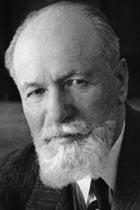Peopleís Artist of the USSR Vladimir Nemirovich-Danchenko | ||
Archives |  Vladimir Ivanovich Nemirovich-Danchenko was born in†Ozurgety (now Makharadze), Georgia, on†December 11, 1858. From an†early age Nemirovich-Danchenko exhibited a†love of†the theater. By†age 13†he†was acting and directing amateur theatricals and already trying out different stage techniques and effects. However, at†age 18†he†set aside his theatrical interests and went to†Moscow, where he†studied physics and mathematics at†the Moscow State University from 1876†to†1879. Theater remained his first love, however, and during this time Nemirovich-Danchenko continued his involvement in†the stage as†a†critic. After leaving school, he†put increased effort into his work as†a†theater critic. Ultimately, while his criticism was much admired, Nemirovich-Danchenko's creative urges sought release in†play-writing and fiction, balancing the analytical side of†his personality. In†the 1890s Nemirovich-Danchenko became a†well-known figure in†Moscow and St.†Petersburg as†a†result of†his plays and his fiction. His first theatrical success, translated as†The New Undertaking or†New Business, premiered in†St.†Petersburg in†1890. Despite the early misgivings of†some of†the cast, and those of†Nemirovich-Danchenko himself, the play proved a†hit with the most important critic of†the day, Flerov-Vassiliev. Nemirovich-Danchenko was awarded Russia's Griboyedov prize as†author of†the best play of†the season by†the Russian Society of†Dramatists. Nemirovich-Danchenko's other plays included Gold, produced in†1895, which had the distinction of†being the first play to†hold a†dress rehearsal in†the history of†Russian theater, and The Worth of†Life, produced in†Moscow in†1896. The Worth of†Life was also awarded the Griboyedov prize, beating out Anton Chekhov's The Seagull. Nemirovich-Danchenko's plays were produced at†the Maly Theater in†Moscow, the Alexandrinsky Theater in†St.†Petersburg, and on†stages throughout the Russian provinces. In†1891Nemirovich-Danchenko used his success with the play The New Undertaking as†a†springboard for furthering his career in†the theater. On†the recommendation of†acting instructor Aleksandr Yuzhin, he†was offered the post of†instructor in†dramatic art at†the Moscow Philharmonic Society. To†his students Nemirovich-Danchenko stressed the need for longer, better-organized rehearsal and a†more flexible acting style. During the years he†taught at†the Philharmonic School Nemirovich-Danchenko published, in†addition to†plays, a†book on†acting translated as†Drama behind the Scenes (1896), as†well as†two works of†fiction: 1896's The Governor's Inspection and 1898's Dreams. Dreams would be†Nemirovich-Danchenko's last work of†fiction, as†by†the time it†was published his career had already begun to†take a†new, historic turn. Recognizing the dreadful state of†Russian theater at†the turn of†the 20th century, Nemirovich-Danchenko arranged to†meet with independent-minded stage director Konstantin Sergeyevich Stanislavsky. In†1897†the legendary meeting took place in†the restaurant of†the Slavyansky Bazaar hotel. The two men discussed the state of†Russian theater, their disappointment in†contemporary drama, and their hopes for a†new style. They remained at†the restaurant long enough to†have lunch and dinner there, then left for Stanislavsky's home to†continue their discussion. In†all, the meeting lasted an†incredible 17†hours, but in†that time the blueprint for the Moscow Art Theatre was drawn up. Originally known as†the Moscow Popular Art Theatre and the Moscow Academic Art Theatre, the Moscow Art Theatre drew its actors from the best of†two groups: Nemirovich-Danchenko's students at†the Moscow Philharmonic School, where he†remained until 1898, and from the Society of†Art and Literature, which Stanislavsky had cofounded in†1888. The influence of†the Moscow Art Theater on†Russian and World Theater in†the late 19th and early 20th centuries cannot be†exaggerated. Not only did the theater revolutionize the style of†acting, leading theater from the mannered to†the natural, but in†producing the plays Nemirovich-Danchenko chose, it†signaled a†quantitative leap into modernism. While Stanislavsky had complete control in†staging the productions, Nemirovich-Danchenko served as†producer and dramaturge†ó he†was in†charge of†selecting new plays for production and also advised Stanislavsky on†interpretation and staging. The first production of†the Moscow Art Theatre occurred on†October 14, 1898. The play was the 1868†historical drama Tsar Fyodor, by†Aleksey Tolstoy. But it†was with their production of†Chekhov's The Seagull that the Moscow Art Theatre achieved its first real success. Nemirovich-Danchenko had always encouraged Chekhov's theatrical aspirations, and he†was the perfect playwright for the theater's philosophy. Thus began a†long collaboration between Chekhov and the Moscow Art Theater that would see acclaimed productions of†Uncle Vanya, The Three Sisters, and The Cherry Orchard. Besides Chekhov's plays, Nemirovich-Danchenko also chose to†present a†production of†William Shakespeare, Gerhart Hauptmann, Henrik Ibsen, Maxim Gorky, Aleksandr Ostrovsky, Saltykov-Shchedrin, Dostoevsky. Following the October 1917†Russian Revolution the theatre troupe traveled abroad and gave performances in†Europe and the United States. This tour lasted from 1922†to†1924, during which time the Moscow Art Theatre gained widespread international acclaim. Nemirovich-Danchenko and Stanislavsky were now as†well known abroad as†they were in†Mother Russia. Nemirovich-Danchenko also was interested in†musical theater, and as†an†adjunct to†the Moscow Art Theatre he†founded the allied Moscow Art Musical Studio in†1919. In†1926†the school's name was changed to†the V.†I.†Nemirovich-Danchenko Musical Theatre and still later to†the Stanislavsky-Nemirovich-Danchenko Musical Theatre. Among the works he†produced or†supervised at†the Musical Theatre were Giuseppi Verdi's La†Traviata, Dmitry Shostakovich's Katerina Izmailova (Lady Macbeth of†Mtsensk), and Carmencita and the Soldier, which is†based on†Georges Bizet's opera, Carmen. In†the late 1920s and 1930s Nemirovich-Danchenko worked within the confines of†Soviet-promoted socialist realism. Particularly praised during his later career were the Moscow Art Theatre's stagings of†Gorky's Enemies (1935) and Chekhov's Three Sisters (1940). Nemirovich-Danchenko worked with the Moscow Art Theatre right up†until its evacuation during World War II.†His autobiography was translated into English in†1936†as†My†Life in†the Russian Theater. Nemirovich-Danchenko was also awarded the State Prize of†the USSR in†1942†and 1943, the Order of†Lenin, and the Order of†the Banner of†Red Labor. He†died in†Moscow on†April 25, 1943. | |
ARTISTIC DIRECTOR ó KONSTANTIN KHABENSKIY

